Are you ready to be dazzled by the purest of pure? Brace yourself for a wild and whimsical adventure as we delve into the enchanting world of 13 beautiful pure white animals. From the majestic Polar Bear to the elegant Swans, these stunning creatures will leave you spellbound. And fear not, dear reader, for we come bearing pictures aplenty! So sit back, relax, and prepare to be captivated by the ethereal beauty of these snow-white wonders. Let’s dive right in, shall we?
1. Polar Bear: The Arctic’s Majestic Monarch
As one ventures into the seemingly endless expanse of the Arctic, the sight of the majestic Polar Bear is a sight to behold. A true icon of the Arctic wilderness, the Polar Bear is renowned for its strikingly beautiful white coat that mirrors the snow-kissed landscapes it calls home.
Fascinatingly, the Polar Bear’s fur isn’t truly white. Instead, it’s translucent, ingeniously reflecting light to give off a shimmering white glow. This remarkable adaptation provides the Polar Bear with the perfect camouflage, cloaking it against the snow and ice, and transforming it into an almost invisible hunter.
Underneath the layers of their gleaming fur lies a layer of black skin, a clever design by Mother Nature to absorb and retain the sun’s warmth, crucial for survival in the harsh Arctic chill.
As the largest land carnivore, male Polar Bears are a formidable sight, weighing in between 900 to 1,600 pounds. Their female counterparts, while smaller, are just as resilient, tipping the scales between 330 to 650 pounds.
Polar Bears are adept hunters and true apex predators. Their primary food source is seals, rich in essential fat that provides the bears with the energy they need to survive and the insulation to protect them from the biting Arctic cold.
Read more: Are Bears and Dogs Actually Related? Unveiling the Fascinating Connection
Below, you’ll find a quick summary of the fascinating facts about the Polar Bear:
| Fact | Details |
|---|---|
| Scientific Name | Ursus maritimus |
| Location | Arctic |
| Fur Color | Translucent (appears white) |
| Skin Color | Black |
| Male Weight | 900 to 1,600 pounds |
| Female Weight | 330 to 650 pounds |
| Primary Diet | Seals |
As we move to the next section, we’ll continue our journey into the world of stunning white animals, exploring the equally captivating and rare White Lion.
2. White Lion: The Majestic Rarity of Timbavati
Imagine emerging from the dense, golden grasslands of South Africa, a creature so majestic and unusual that it seems to have stepped straight out of a storybook. This is the White Lion, a rare and distinctive variant of the Southern Lion subspecies. Predominantly found in the Timbavati region, these lions are a sight to behold, their white coats shimmering against the rugged African landscape.
What makes these lions stand out is not albinism, as one might initially presume. Instead, their unique pigmentation—or rather, the lack of it—is a result of a rare genetic condition known as leucism. Unlike albinism, which results in a complete lack of pigmentation, leucism merely causes a reduction. This fascinating genetic variance allows them to retain some pigmentation in their eyes, skin, and hair, granting them their characteristic appearance.
Check out: How Strong Are Orangutans? Discover Their Astonishing Power!
One might believe that such a stark difference from their tawny counterparts would hinder their survival. Yet, these lions have proven that assumption wrong. Despite their striking appearance, white lions are proficient hunters, capable of thriving in their natural habitats. Their strength and resilience are testaments to their survival instincts, demonstrating that even in the wild, standing out does not always equate to vulnerability.
However, it is this very distinctiveness that has made the White Lion a prime target for exploitation. Their rarity and beauty have made them sought after in both canned hunting—a reprehensible practice where animals are hunted in confined areas—and the exotic pet trade. This exploitation is a stark reminder of the human-induced threats many of these pure white animals face.
From the icy expanses where Polar Bears roam to the sun-drenched African savannas of the White Lions, the beauty of these pure white creatures is undeniably captivating. As we journey further into the realm of these magnificent beings, we’ll next encounter a creature that embodies the essence of the Arctic wilderness—the Arctic Fox.
3. Arctic Fox: The White Phantom of the North
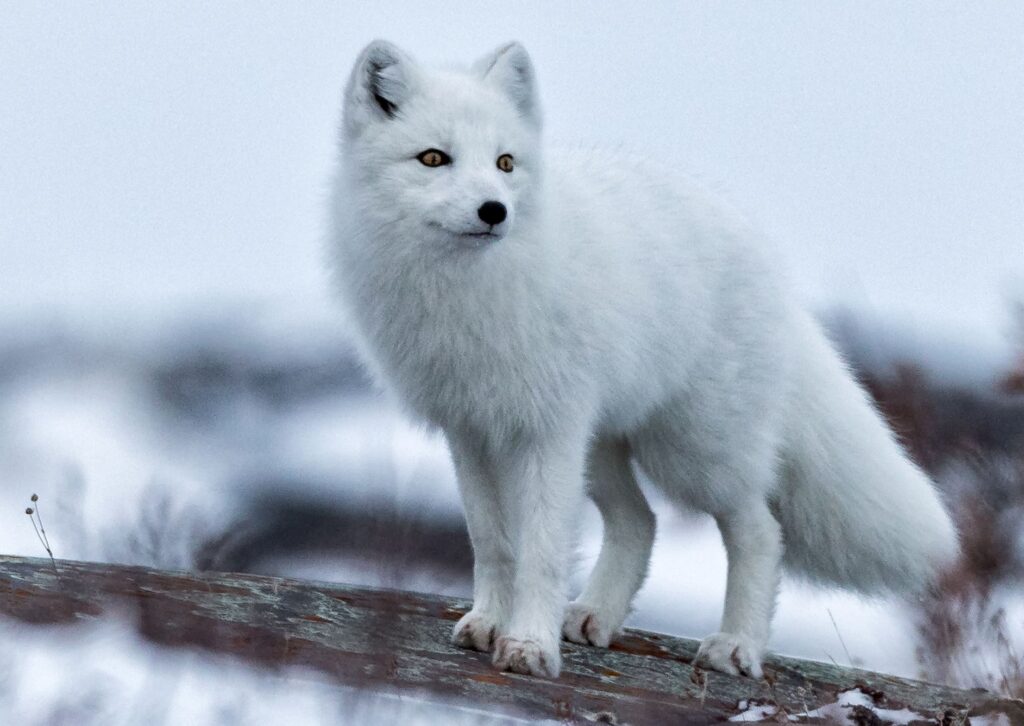
artic fox
Stepping into the icy realm of the Arctic, we encounter the Arctic Fox, a beguiling creature that epitomizes survival in one of the planet’s harshest environments. This petite yet nimble mammal, scientifically known as Vulpes lagopus, paints a striking picture against the stark, snowy wilderness.
The Arctic Fox, much like an enchanting chameleon of the North, boasts a thick, warm coat that transforms with the seasons. In the heart of winter, it dons a pristine white fur, becoming virtually invisible against the expansive icy backdrop. This ingenious camouflage acts as an essential survival tool, allowing it to stealthily stalk prey and evade predators. However, as the Arctic tundra thaws and the landscape morphs from white to hues of brown and grey, so does the Arctic Fox’s coat, offering effective blending into the tundra landscape.
Despite their petite size, these foxes are omnivorous and opportunistic feeders. Their diet is a testament to their adaptability, consisting of small mammals, birds, and fish. Often, these Arctic survivors demonstrate their cunning and resourcefulness by scavenging on leftover carcasses from other predators, a strategy that ensures no meal goes to waste in the unforgiving Arctic wilderness.
Check out: Unleashing the Roar: Decoding the Bite Force of a Lion and Its Crushing Power Revealed
However, the Arctic Fox faces unprecedented challenges as a result of climate change. Rising temperatures are causing their icy home to recede, altering their ecosystem. Simultaneously, it is paving the way for the expansion of red foxes into their territory. This intrusion leads to increased competition for resources, threatening the Arctic Fox’s survival.
From their intricate survival strategies to their fascinating color-changing coats, the Arctic Fox is truly a marvel of the Arctic, and one of the most beautiful pure white animals to behold.
4. The Arctic Hare: The High-Speed Herbivore of the Arctic Tundra
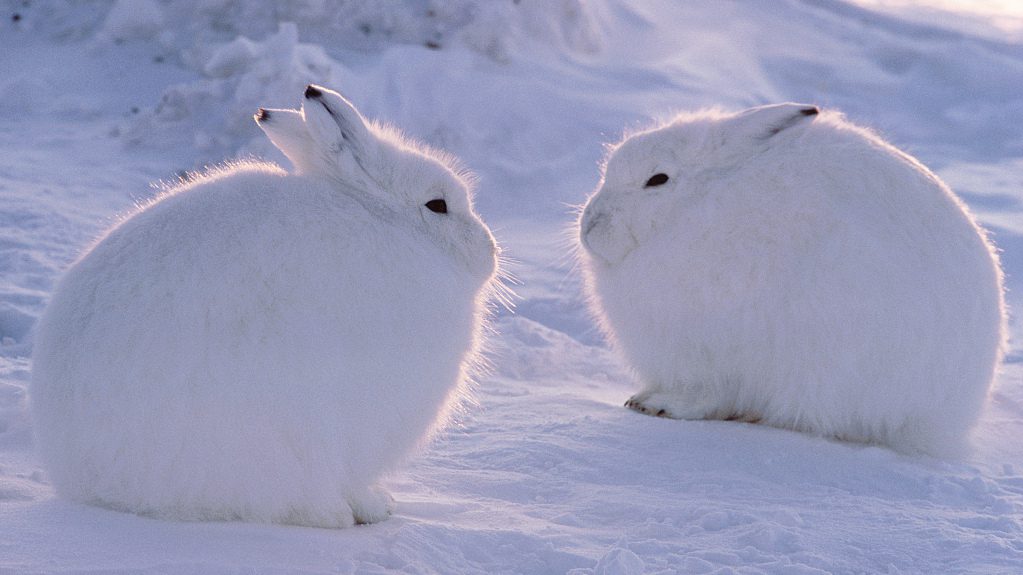
the artic hare
As we continue our exploration of pure white animals, let’s journey to the extreme conditions of the Arctic tundra, where one of the most resilient creatures resides – The Arctic Hare. This hardy animal, like its Arctic Fox neighbor, has a built-in survival mechanism: a coat of thick, pure-white fur during the harsh winter months. This fur, as soft as it is practical, acts as a perfect camouflage against the snow, making the Arctic Hare almost invisible to predators and adding a touch of magic to the frosty landscape.
However, the Arctic Hare is not just a pretty face in the snow. They are known for their remarkable agility, capable of reaching heart-stopping speeds of up to 60 km/h (37 mph). They can dart across the icy tundra with the velocity of a snowstorm, evading predators such as the cunning Arctic Fox and various birds of prey.
Imagine witnessing an Arctic Hare in action, a blur of white against the snowy backdrop, moving with such speed that it seems almost unreal. This is the spectacle that the Arctic wilderness offers.
But what does this swift creature eat to sustain such energy? As herbivores, Arctic Hares feed on the sparse vegetation available in their harsh environment. In the biting cold of winter, they nibble on woody plants, mosses, and lichens. As the seasons change and the Arctic terrain transforms from a winter wonderland to a rocky desert, the hare’s fur transitions too. It turns into a blue-gray color, ideal for blending in with the rocky landscape. During these warmer months, their diet consists of grasses, leaves, and flowers.
Read more about: Unveiling the Secrets of a Lion’s Tongue: All You Need To Know
Thus, the Arctic Hare, with its speed, adaptability, and pure white winter fur, is more than just a beautiful creature. It’s a testament to nature’s incredible ability to adapt and survive in the most challenging conditions.
Let’s continue our journey to discover more fascinating pure white animals, each with their own unique adaptations and stories to tell. Up next, we dive into the waters to meet the beloved Beluga Whale.
5. The Enchanting Beluga Whale
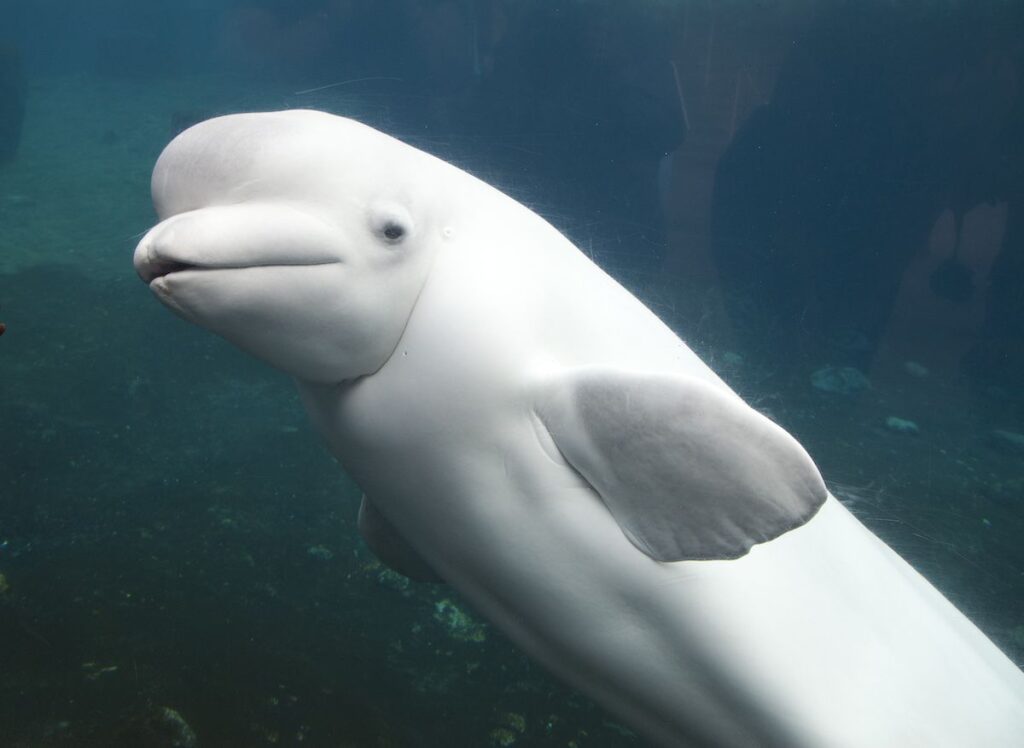
beluga whale
As we continue our exploration of the pure white wonders of the animal kingdom, we journey from the Arctic tundra, home to the Arctic Fox and Arctic Hare, into the icy waters of the Arctic and subarctic oceans. Here, we find the Beluga Whale. This marine mammal, with its striking white appearance and unique features, is a testament to nature’s incredible adaptability.
Imagine a creature of profound beauty, its body blending seamlessly with the icy landscape. Its skin is as white as the purest snow, a perfect adaptation for life in the Arctic’s icy waters. This is the Beluga, a creature of many fascinating contrasts.
One of its most distinctive features is its rounded forehead, known as a “melon”. This bulbous structure is not just for show — it plays a crucial role in the Beluga’s complex communication system. In fact, their vocalizations are so diverse and melodic that they’ve earned the enchanting nickname: the “canaries of the sea“.
Belugas are highly social animals, living in groups called pods. These pods, often containing up to 25 individuals, create a beautiful spectacle in the icy waters they inhabit. Together, they traverse the sub-zero temperatures, their thick layer of insulating blubber protecting them from the cold.
Beluga Whales are not just beautiful; they are survivors, perfectly adapted to their environment. Their white coloration is not just appealing to the eye but serves a vital purpose. It provides camouflage, hiding them from potential predators and allowing them to blend seamlessly with the icy Arctic waters.
As we continue our journey, exploring the incredible diversity of pure white animals in the next sections, let’s not forget the enchanting Beluga Whale. It stands as a symbol of resilience and adaptability, reminding us of the wonders of the natural world and the importance of preserving it.
6. The Enchanting White-Tailed Ptarmigan
Leaping from the icy depths of the Arctic seas where the Beluga Whale thrives, we find ourselves in the captivating high-altitude landscapes of Northwestern North America. Here, a little-known creature walks the terrain, boasting an equally remarkable ability to adapt and survive. Meet the White-Tailed Ptarmigan, a small, ground-dwelling bird with a big secret.
Unlike the Arctic Hare and Beluga Whale, the Ptarmigan doesn’t rely on the same color all year round for its survival. This whimsical creature wears a mottled brown plumage in the summer, blending seamlessly with the rocky alpine terrain. But as winter sets in and the landscape transforms into a snowy wonderland, the Ptarmigan undergoes a magical transformation. Its summer coat gives way to a pure white plumage, offering perfect camouflage against the snow-clad surroundings. This seasonal wardrobe change is a breathtaking spectacle of nature’s adaptability.
Also referred to as the Snow Quail, the White-Tailed Ptarmigan is the smallest member of the grouse family. It resides in high-altitude habitats, perched between 2,000 to 5,000 meters above sea level, navigating the rugged and often harsh environment with a grace that belies its small size.
Also check out: Leopard vs. Cougar: What Makes Them Different and Who Prevails in a Battle?
When it comes to sustenance, the Ptarmigan is a herbivore, nourishing itself on a varied diet that includes leaves, flowers, seeds, and buds. As the winter season restricts the availability of fresh greenery, this resilient bird switches to feeding on woody plants and evergreen needles, displaying an extraordinary ability to adapt its diet to the changing seasons.
Through the story of the White-Tailed Ptarmigan, we witness yet another awe-inspiring tale of survival in the world of white animals, each adapting in unique ways to thrive in their respective environments.
From the mighty Polar Bear to the agile Arctic Hare, the communicative Beluga Whale, and now, the adaptive White-Tailed Ptarmigan, it’s clear that nature’s canvas is richly painted with these remarkable creatures. And we still have more to explore! So let’s continue our journey into the world of these beautiful pure white animals.
7. The Enchanting Elegance of the White Peafowl
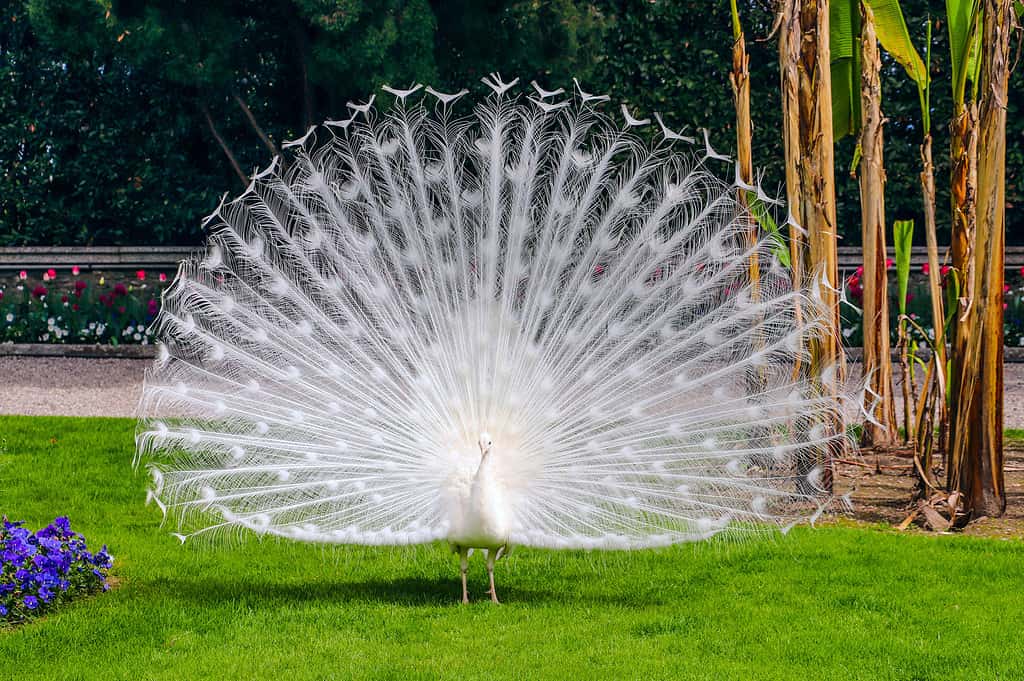
white peafowl
Imagine a bird, resplendent in pure white, unfurling its majestic tail feathers in a mesmerizing dance. This isn’t a scene from a fairytale, but a close look at the captivating White Peafowl. Ah, the White Peafowl! It’s an absolutely stunning bird, so unique and breathtaking that it seems to have stepped right out of a dream.
While its ethereal beauty captivates our senses, the story behind the White Peafowl’s all-white plumage is equally fascinating. This bird is not a different species but rather a genetic variation of the common Indian or Blue Peafowl. The reason behind its enchanting white plumage lies in a condition called leucism. This genetic condition causes a reduction in pigmentation, resulting in the bird’s white feathers.
Unlike albino animals that lack all pigmentation, leucistic peafowls still possess some coloration in their eyes, adding to their unique charm.
The White Peafowl, with its mesmerizing beauty, shares the same behaviors and characteristics as its colorful counterparts. One of the most captivating of these behaviors is the male peafowl’s courtship ritual. During the mating season, the male unfurls his impressive train of long tail feathers, creating a spectacle that is hard to forget.
He then performs an extraordinary dance, a ballet of nature designed to attract females. Thus, the seemingly serene and quiet White Peafowl transforms into a dynamic performer, adding a layer of complexity and intrigue to their persona.
Even though White Peafowls are native to South Asia, their stunning beauty has made them popular across the globe. They are now found in captivity around the world, enchanting people with their ethereal elegance wherever they go.
Beauty, adaptability, and a captivating courtship dance – the White Peafowl encapsulates the magic of the wild, making it one of the most extraordinary white animals on our planet.
8. The Enchanting White Dove: A Symbol of Peace and Purity
From the icy peaks inhabited by the White-Tailed Ptarmigan to the vibrant hues of the White Peafowl, we now take flight to explore a creature that dwells closer to human habitats. A bird that carries universal symbolism and radiates an aura of tranquility – the White Dove.
Scientifically known as Streptopelia risoria, the White Dove is a domesticated descendent of the African Collared Dove. Unlike its wild counterpart, the White Dove is not a species found in natural habitats but has been bred specifically for its striking white plumage. This beautiful creature, a marvel in its own right, is an embodiment of purity and peace, and is revered across cultures and religions around the globe.
“A symbol of peace, love, and purity, the White Dove often makes a heavenly appearance at weddings, funerals, and religious ceremonies.”
But beneath its emblematic significance, the White Dove is a resilient creature, capable of thriving in diverse environments. This hardiness, combined with its gentle nature, makes it a favorite choice among bird enthusiasts.
When it comes to diet, the White Dove is a seed and fruit lover. However, don’t be fooled by its demure demeanor; it can occasionally indulge in a protein-rich snack of insects. Not only does this diet provide the necessary nutrients for these birds, but it also contributes to maintaining their pristine white feathers.
Read more about: “Unveiling Mexico’s Majestic Emblem: Meet the Golden Eagle, the National Animal”
With their calm personality and their ethereal beauty, it’s no wonder the White Dove has become a popular pet among bird keepers globally. So, as we continue our journey through the world of these beautiful white animals, we can’t help but marvel at the versatility and resilience of these creatures, each fascinating in their own unique ways.
9. Goldenrod Crab Spider
From the snowy realms of the Arctic to the vibrant colors of peacocks, our exploration of white animals takes us now to the fascinating world of arachnids. Our next guest, the Goldenrod Crab Spider, is an ingenious master of disguise, residing primarily in North America, Europe, and parts of Asia. But don’t let the name fool you; its ability to don a snowy white cloak makes it a fitting addition to our list.
Imagine a meadow on a bright sunny day, flowers swaying gently in the breeze. At first glance, all seems calm and serene, but upon closer inspection, a small drama unfolds. A white figure, almost invisible against the petals of a flower, waits in perfect stillness. This is the Misumena vatia, or as we know it, the Goldenrod Crab Spider.
Unlike their web-spinning cousins, Goldenrod Crab Spiders are ambush predators. They do not ensnare their prey in a web. Instead, they exercise a unique form of hunting that relies heavily on their extraordinary camouflage abilities and robust front legs. This spider can change its color from yellow to white and vice versa, a perfect adaptation to blend seamlessly with the flowers it inhabits.
“Their camouflage is so perfect that they become virtually invisible to their prey.”
With a swift, precise movement, the spider captures its unsuspecting victim, often a bee or butterfly, using its powerful front legs. A quick injection of venom immobilizes the prey, paving the way for a leisurely meal. This distinctive hunting style makes the Goldenrod Crab Spider a fascinating example of nature’s survival strategies.
Interestingly, there is a noticeable size difference between the genders. The females, measuring 7-10 mm, are significantly larger than their male counterparts, who reach only 3-4 mm in length. Also, while the females are vividly colored, the males bear a more muted brown or gray hue.
Whether it’s the snowy plumage of a peafowl or the ethereal beauty of a white dove, the art of blending in is a common thread in our exploration of white animals. In the case of the Goldenrod Crab Spider, it’s a life-saving strategy perfected over countless generations.
10. Albino Texas Rat Snake
Emerging as a radiant spectacle of nature’s artistry, the Albino Texas Rat Snake captivates the eyes with its mesmerizing all-white scales. This enchanting reptile is not just a pretty face, but a fascinating genetic anomaly. The snake’s ethereal beauty is a result of a genetic mutation known as albinism, a condition that renders the absence of melanin — the pigment that paints color in animals.
Just like the previously discussed White Dove, the Albino Texas Rat Snake stands out in its environment, but for different reasons. Unlike the dove which is naturally white, the snake’s albinism is an exception in the animal kingdom. It’s an anomaly that transforms the typically dull brown or gray rat snake into a visually striking creature, almost like an elegant ghost slithering through the underbrush.
Fact: The Albino Texas Rat Snake’s scientific name is Pantherophis obsoletus lindheimeri. It’s a type of reptile predominantly found in the Southern United States.
Albinism does not only change the snake’s skin but also imparts a unique characteristic to its eyes. If you’ve ever wondered why albino animals often have red eyes, it’s because the clear lens allows the visibility of blood vessels. This intriguing detail adds a captivating contrast to the snake’s pure white body, enhancing its enigmatic appeal.
However, the snake’s spectacular appearance comes with a caveat. Being an albino animal is a challenging ordeal in the wild. Their striking white hue makes them conspicuous, hence more vulnerable to predation. It’s as if they are illuminated billboards in the wild, standing out against the backdrop of their habitat.
Fact: The Texas Rat Snake is a subspecies of the Western Rat Snake (Pantherophis obsoletus) and is native to the United States, primarily found in Texas, Louisiana, and Oklahoma. They are nonvenomous snakes.
Despite their vulnerability in the wild, these snakes are quite popular among reptile enthusiasts. Their unique coloration, coupled with their nonvenomous nature, makes them ideal for breeding in captivity. So while they might struggle to survive in the wild, they thrive in the care of humans, adding a touch of exotic beauty to their collections.
Stay tuned for our next entry, the Arctic Wolf, another majestic creature draped in a coat of pure white.
11. Arctic Wolf: The White Predator of the North
On our journey through the world of stunning white creatures, we now find ourselves amidst the chilling winds and snow-covered landscapes of the Canadian Arctic. Here, amidst the biting cold and vast icy plains, resides the resilient Arctic Wolf (Canis lupus arctos), a subspecies of the Gray Wolf.
Unlike the Goldenrod Crab Spider and Albino Texas Rat Snake, who rely on venom and stealth respectively, the Arctic Wolf uses its physical prowess and pack mentality to survive in one of the Earth’s harshest environments. This stark contrast has been carefully etched by Mother Nature herself, highlighting the diverse survival strategies that exist within the animal kingdom.
Adapted to life in the frosty Arctic, the Arctic Wolf boasts a brilliant white coat that serves as both an effective camouflage and a shield against the relentless cold. Underneath this white facade lies a dense undercoat, providing an additional layer of insulation to combat the extreme Arctic temperatures.
Yet, what truly sets these Arctic predators apart is their pronounced social structure and family bonds. Living in organized packs, they portray a fascinating example of social cohesion and cooperation, a stark contrast to the solitary hunting spider or an individual snake.
Read more: “Are These the 10 Largest Wolves on the Planet? Unveiling the Mighty Beasts”
Their diet mainly comprises caribou, muskoxen, and Arctic hares, showcasing their adaptability to the limited prey options available in the icy wilderness. Notably, these wolves are known to travel long distances in pursuit of their prey, a testament to their endurance and determination.
As we venture further into our exploration of pure white animals, let us carry forth the image of the Arctic Wolf, the white-furred guardian of the Arctic tundra, whose beauty, resilience, and adaptability truly epitomize the marvels of nature.
12. The Enchanting Dance of the Small White Butterfly
Imagine a sunny day, the sky a brilliant blue canvas. Suddenly, a delicate flutter catches your eye. A seemingly delicate creature, dancing in the air, tracing patterns only it comprehends. Its wings, a pristine white, are punctuated with black spots and wingtips, offering a stark contrast against the azure backdrop. This beautiful ballet in the sky is the performance of none other than the Small White Butterfly.
Known also as the Small Cabbage White, this butterfly species is as widespread as it is common. However, its ubiquitous presence does not diminish the joy of spotting one. Its habitat is as diverse as the continents it inhabits, stretching from the gardens in your backyard to meadows that roll on as far as the eye can see, and even to agricultural fields brimming with life.
With a fondness for cabbage plants, the Small White has earned its alternate nickname. These plants serve as a primary host for their larvae, marking the start of a new life cycle. Yet, this affinity for cabbage has also earned them the status of being pests, a testament to nature’s irony where survival sometimes comes at the cost of another’s inconvenience.
Adult Small Whites are ardent nectar lovers. Their diet consists of a diverse array of flowering plants, with each visit contributing to the important process of pollination. This unassuming insect, therefore, plays a vital role in maintaining the balance of our ecosystems.
So, the next time you spot a Small White Butterfly, take a moment to appreciate its beauty and the silent, significant role it plays in our world. After all, in the grand tapestry of nature, every thread, no matter how small, is essential. And remember, the grace and resilience of this butterfly is another magnificent testament to the beauty of pure white animals.
13. Swans: The Majestic Waterbirds in Pure White
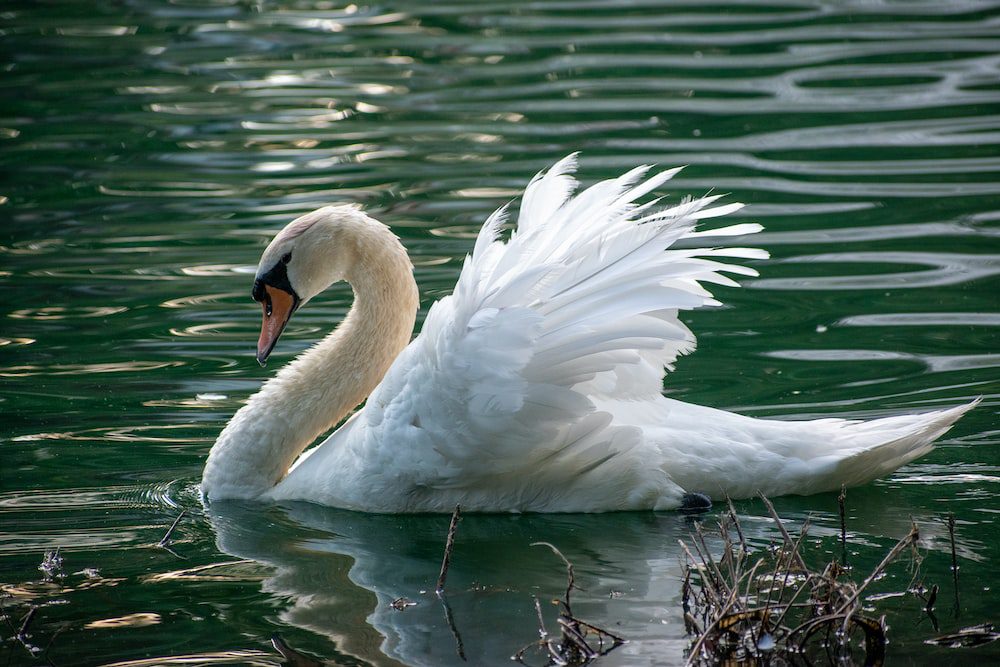
swan
Having discovered the wonders of Arctic Wolves and the delicate Small White Butterfly, let us now set our gaze upon the enchanting world of Swans. These magnificent creatures are synonymous with grace and beauty, much like the sublime purity of winter’s first snowfall. Swans belong to the family Anatidae, a family of birds that includes ducks and geese, but they stand out with their extraordinary elegance and majestic white plumage.
Swans are celebrated for their long, curved necks, a characteristic that not only lends them a unique beauty but also aids them while foraging underwater. Among these waterbirds, species like the Mute Swan, Whooper Swan, and Tundra Swan are predominantly white, their gleaming feathers often symbolizing purity and serenity in various cultures.
Swans aren’t just beautiful; they’re storytellers too. Their lives are woven with tales of enduring love and intricate dance rituals. They form monogamous pair bonds that often last a lifetime, a testament to their unwavering commitment. The courtship rituals of these birds are nothing less than a ballet performance. Synchronized swimming and head-bobbing create mesmerizing displays that are a joy to behold.
Swans, with their long, curved necks and beautiful white plumage, are more than just visual treats. They embody stories of love, commitment, and grace, making them truly special among pure white animals.
So, as we revel in the beauty of these pure white animals, let’s appreciate not just their physical attributes but also the fascinating behaviors and characteristics that make each of them unique. From the resilience of the Arctic Wolf to the delicate charm of the Small White Butterfly, and now, the graceful elegance of Swans, each creature adds a unique thread to the tapestry of nature’s splendor.
The article is about 13 beautiful pure white animals.
The white coloration can serve various purposes, such as camouflage and thermoregulation.
Polar bears have translucent fur that allows them to blend in with their snowy surroundings.
The Polar Bear is the largest land carnivore.

